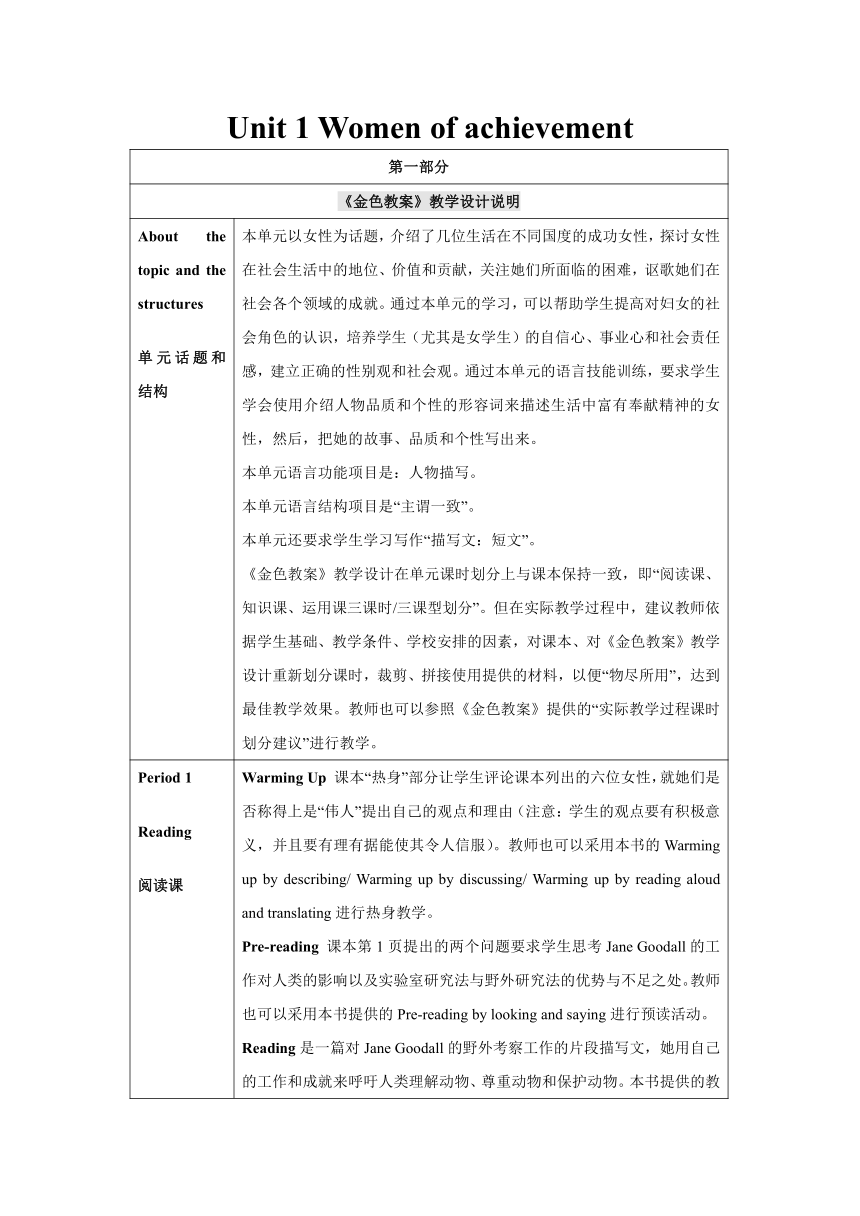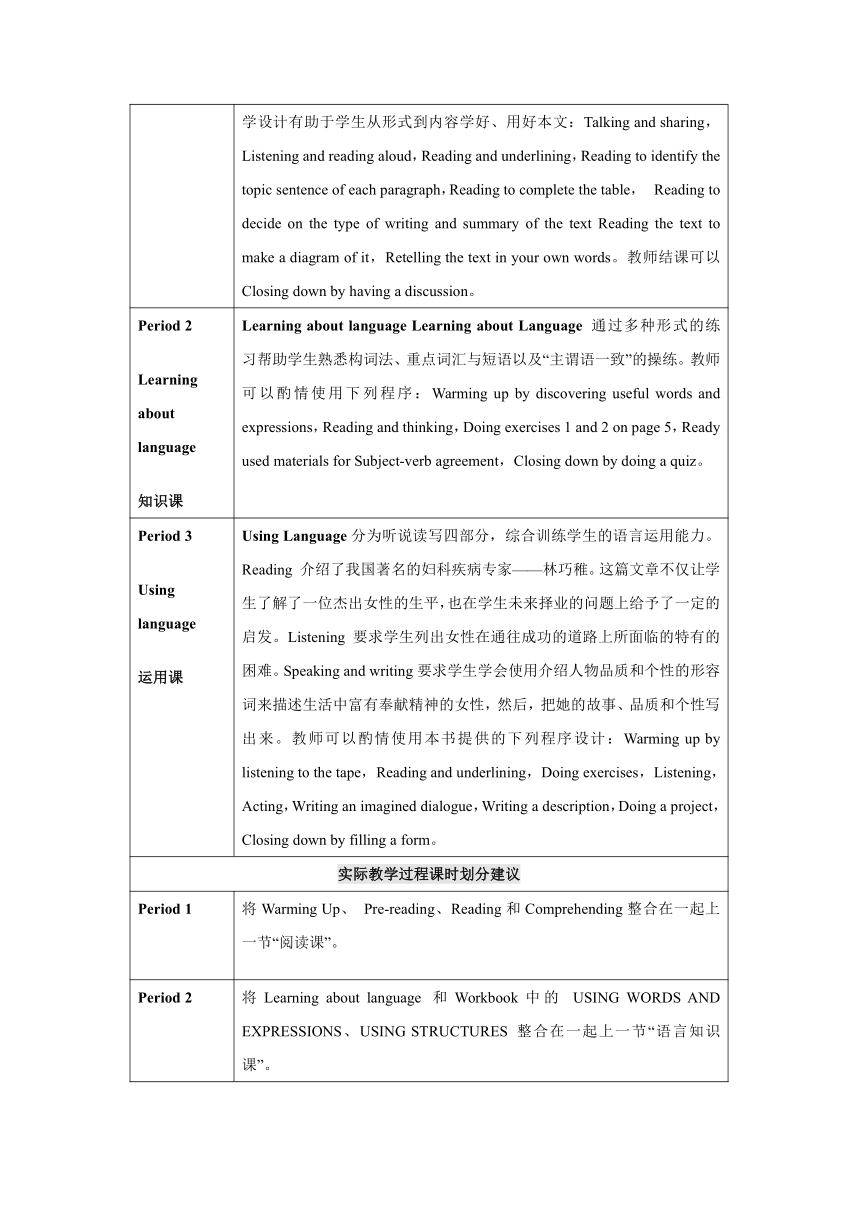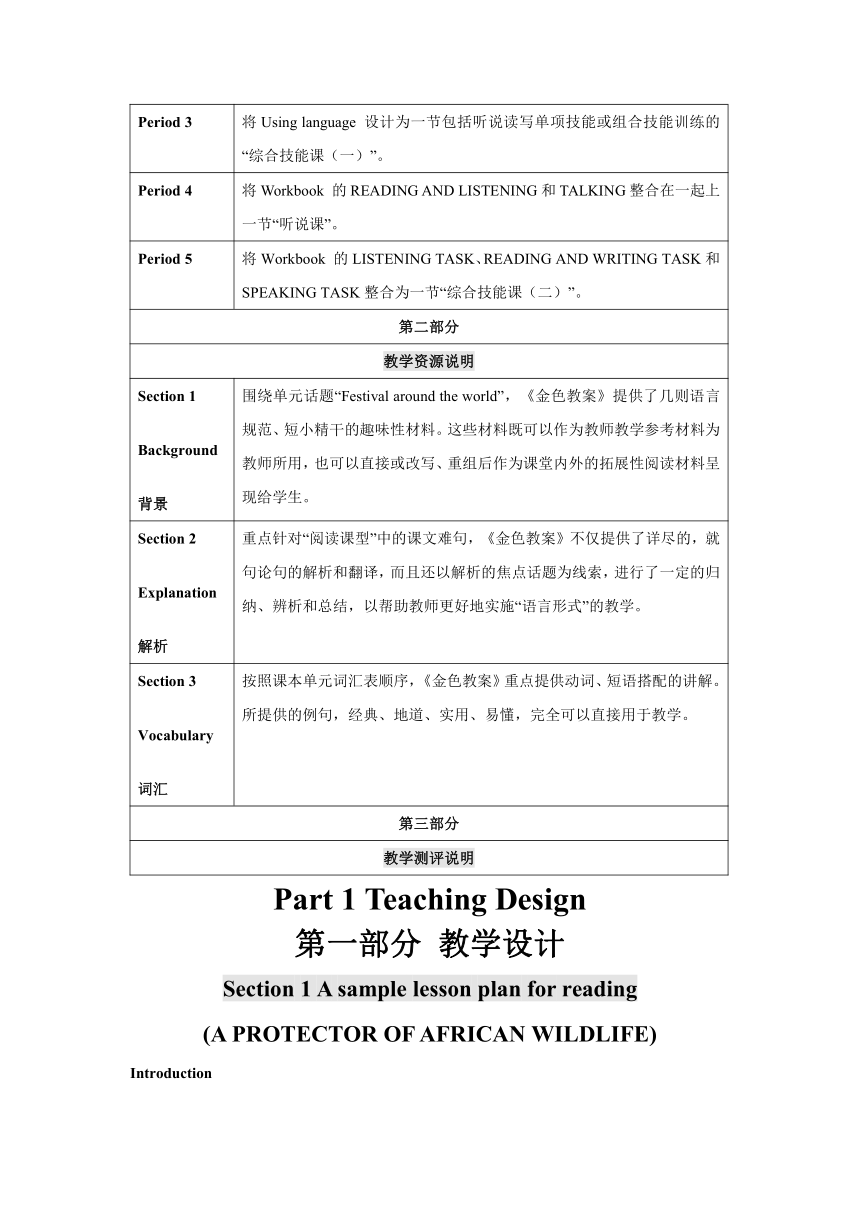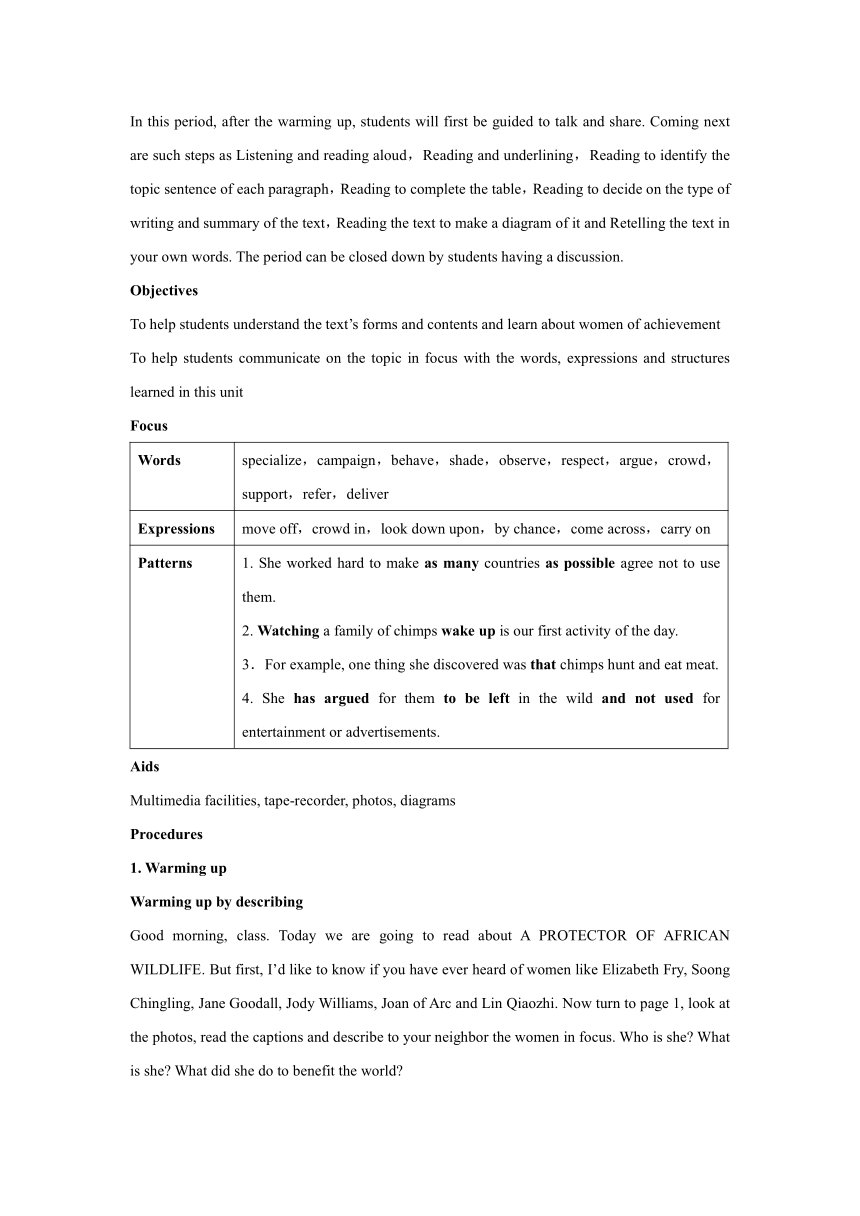必修4 Unit 1 Women of achievement 教案
文档属性
| 名称 | 必修4 Unit 1 Women of achievement 教案 |

|
|
| 格式 | doc | ||
| 文件大小 | 79.0KB | ||
| 资源类型 | 教案 | ||
| 版本资源 | 人教版(新课程标准) | ||
| 科目 | 英语 | ||
| 更新时间 | 2021-11-12 16:43:15 | ||
图片预览




文档简介
Unit 1 Women of achievement
第一部分
《金色教案》教学设计说明
About the topic and the structures单元话题和结构 本单元以女性为话题,介绍了几位生活在不同国度的成功女性,探讨女性在社会生活中的地位、价值和贡献,关注她们所面临的困难,讴歌她们在社会各个领域的成就。通过本单元的学习,可以帮助学生提高对妇女的社会角色的认识,培养学生(尤其是女学生)的自信心、事业心和社会责任感,建立正确的性别观和社会观。通过本单元的语言技能训练,要求学生学会使用介绍人物品质和个性的形容词来描述生活中富有奉献精神的女性,然后,把她的故事、品质和个性写出来。本单元语言功能项目是:人物描写。本单元语言结构项目是“主谓一致”。本单元还要求学生学习写作“描写文:短文”。《金色教案》教学设计在单元课时划分上与课本保持一致,即“阅读课、知识课、运用课三课时/三课型划分”。但在实际教学过程中,建议教师依据学生基础、教学条件、学校安排的因素,对课本、对《金色教案》教学设计重新划分课时,裁剪、拼接使用提供的材料,以便“物尽所用”,达到最佳教学效果。教师也可以参照《金色教案》提供的“实际教学过程课时划分建议”进行教学。
Period 1Reading 阅读课 Warming Up 课本“热身”部分让学生评论课本列出的六位女性,就她们是否称得上是“伟人”提出自己的观点和理由(注意:学生的观点要有积极意义,并且要有理有据能使其令人信服)。教师也可以采用本书的Warming up by describing/ Warming up by discussing/ Warming up by reading aloud and translating进行热身教学。Pre-reading 课本第1页提出的两个问题要求学生思考Jane Goodall的工作对人类的影响以及实验室研究法与野外研究法的优势与不足之处。教师也可以采用本书提供的Pre-reading by looking and saying进行预读活动。Reading是一篇对Jane Goodall的野外考察工作的片段描写文,她用自己的工作和成就来呼吁人类理解动物、尊重动物和保护动物。本书提供的教学设计有助于学生从形式到内容学好、用好本文:Talking and sharing,Listening and reading aloud,Reading and underlining,Reading to identify the topic sentence of each paragraph,Reading to complete the table, Reading to decide on the type of writing and summary of the text Reading the text to make a diagram of it,Retelling the text in your own words。教师结课可以 Closing down by having a discussion。
Period 2Learning about language 知识课 Learning about language Learning about Language 通过多种形式的练习帮助学生熟悉构词法、重点词汇与短语以及“主谓语一致”的操练。教师可以酌情使用下列程序:Warming up by discovering useful words and expressions,Reading and thinking,Doing exercises 1 and 2 on page 5,Ready used materials for Subject-verb agreement,Closing down by doing a quiz。
Period 3Using language运用课 Using Language分为听说读写四部分,综合训练学生的语言运用能力。Reading 介绍了我国著名的妇科疾病专家——林巧稚。这篇文章不仅让学生了解了一位杰出女性的生平,也在学生未来择业的问题上给予了一定的启发。Listening 要求学生列出女性在通往成功的道路上所面临的特有的困难。Speaking and writing要求学生学会使用介绍人物品质和个性的形容词来描述生活中富有奉献精神的女性,然后,把她的故事、品质和个性写出来。教师可以酌情使用本书提供的下列程序设计:Warming up by listening to the tape,Reading and underlining,Doing exercises,Listening,Acting,Writing an imagined dialogue,Writing a description,Doing a project,Closing down by filling a form。
实际教学过程课时划分建议
Period 1 将Warming Up、 Pre-reading、Reading和Comprehending整合在一起上一节“阅读课”。
Period 2 将Learning about language 和Workbook中的 USING WORDS AND EXPRESSIONS、USING STRUCTURES 整合在一起上一节“语言知识课”。
Period 3 将Using language 设计为一节包括听说读写单项技能或组合技能训练的“综合技能课(一)”。
Period 4 将Workbook 的READING AND LISTENING和TALKING整合在一起上一节“听说课”。
Period 5 将Workbook 的LISTENING TASK、READING AND WRITING TASK和 SPEAKING TASK整合为一节“综合技能课(二)”。
第二部分
教学资源说明
Section 1Background 背景 围绕单元话题“Festival around the world”,《金色教案》提供了几则语言规范、短小精干的趣味性材料。这些材料既可以作为教师教学参考材料为教师所用,也可以直接或改写、重组后作为课堂内外的拓展性阅读材料呈现给学生。
Section 2Explanation解析 重点针对“阅读课型”中的课文难句,《金色教案》不仅提供了详尽的,就句论句的解析和翻译,而且还以解析的焦点话题为线索,进行了一定的归纳、辨析和总结,以帮助教师更好地实施“语言形式”的教学。
Section 3Vocabulary词汇 按照课本单元词汇表顺序,《金色教案》重点提供动词、短语搭配的讲解。所提供的例句,经典、地道、实用、易懂,完全可以直接用于教学。
第三部分
教学测评说明
Part 1 Teaching Design
第一部分 教学设计
Section 1 A sample lesson plan for reading
(A PROTECTOR OF AFRICAN WILDLIFE)
Introduction
In this period, after the warming up, students will first be guided to talk and ing next are such steps as Listening and reading aloud,Reading and underlining,Reading to identify the topic sentence of each paragraph,Reading to complete the table,Reading to decide on the type of writing and summary of the text,Reading the text to make a diagram of it and Retelling the text in your own words. The period can be closed down by students having a discussion.
Objectives
To help students understand the text’s forms and contents and learn about women of achievement
To help students communicate on the topic in focus with the words, expressions and structures learned in this unit
Focus
Words specialize,campaign,behave,shade,observe,respect,argue,crowd,support,refer,deliver
Expressions move off,crowd in,look down upon,by chance,come across,carry on
Patterns 1. She worked hard to make as many countries as possible agree not to use them. 2. Watching a family of chimps wake up is our first activity of the day. 3.For example, one thing she discovered was that chimps hunt and eat meat. 4. She has argued for them to be left in the wild and not used for entertainment or advertisements.
Aids
Multimedia facilities, tape-recorder, photos, diagrams
Procedures
1. Warming up
Warming up by describing
Good morning, class. Today we are going to read about A PROTECTOR OF AFRICAN WILDLIFE. But first, I’d like to know if you have ever heard of women like Elizabeth Fry, Soong Chingling, Jane Goodall, Jody Williams, Joan of Arc and Lin Qiaozhi. Now turn to page 1, look at the photos, read the captions and describe to your neighbor the women in focus. Who is she What is she What did she do to benefit the world
Warming up by discussing
Hi, every one. How did you spend your winter vacation Did you read any books Did you read any women of achievement What makes a woman of achievement Now in pairs discuss the women on page one. Which of these women do you think is a great woman And may I have your reasons for your choice
Warming up by reading aloud and translating
Nice to see you back at school, boys and girls. As you have all prepared lessons before class I shall ask six of you at random to read aloud and translate the captions under the photos on page one to see how you’ve understand these women. Zhao Yanfei, would you try reading aloud and translating the first caption
Key for reference: 伊丽莎白·弗赖伊是一位教友派信徒。她帮助改善了监禁条件,向囚犯提供工作和教育机会。 她的工作帮助教友派赢得了1947年度的诺贝尔和平奖。
Well done! Next let’s have Ju Xiaohong do the second one.
2. Pre-reading by looking and saying
Work in pairs. Look at the photos and the title A PROTECTOR OF AFRICAN WILDLIFE and predict the contents of the text. When you are ready, join another pair and compare your predictions and the clues that helped you to make the predictions.
Key for reference: From the photos and title I guess that the text tells about a woman scientist who is working in Africa to protect the wildlife there. She studies a family of chimps, delivers a speech on their behavior, arguing for them to be left in the wild and protected.
3. Talking and sharing
Work in groups of four. Tell your group mates what you know about wildlife protection. Then the group leader is to stand up and share your group idea with the class.
Key for reference: I am from Group 3. We think that Jane is a woman of achievement. For she has helped people understand how much chimps behave like humans. Because of her we know that it is better for the animals to be left in the wild or in the special places set up for them.
4. Listening and reading aloud
Reading aloud to the recording of the text improves our literacy skills -- reading, writing, speaking, and listening. Now please listen and then read the text aloud. Pay attention to the pronunciation of each word and the pauses within each sentence. I will play the tape twice and you shall read aloud twice, too.
5. Reading and underlining
A really useful way to help us with our listening is to become aware of ‘thought groups’ .
When we speak, we need to divide speech up into small ‘chunks’ to help the listener understand messages. These chunks or thought groups are groups of words which go together to express an idea or thought. In English, we use pauses and low pitch to mark the end of thought groups.
Next you are to read the text, dividing the text into thought groups and circling all the useful expressions or collocations in the passage. Copy them into your notebook after school as homework.
Collocations from A PROTECTOR OF AFRICAN WILDLIFEmake a great person 造就一个伟人, give reasons for… 给出理由, improve prison conditions 改善监狱的条件, give sb. work and education 为某人提供工作和受教育的机会, get the Nobel Peace Prize 获得诺贝尔和平奖, in modern Chinese history 在中国现代史上, concern oneself with…从事;忙于;关心, show the connection between… and…表明……与……之间的联系, found an international campaign发起一项国际运动, stop the use of landmines 停止使用地雷, give sb. the Nobel Peace Prize 授予……诺贝尔和平奖, fight for…为……而战, drive…out of…把……赶出去, put sb. to death 杀死或处死某人, become a specialist in women’s illnesses 成为妇科疾病的专家, devote all one’s life to…一生致力于……, encourage sb. to do sth. 鼓励……做……, behave like humans 像人类一样活动, leave sb. sleeping让……睡着, wander off into the forest 晃晃悠悠地走进森林, make …all worthwhile使得……都非常值得, spend years observing and recording their daily activities 用多年时间观察和记录它们的日常活动, be determined to do sth.下定决心做某事, in one’s own environment 在……自己的生存环境中, begin one’s project 开始……的计划, communicate with each other 互相交流, work out…解决;算出, respect the life of…尊重……的生活, leave…in the wild 让……生活在野生世界, use… for entertainment or advertisements 用于娱乐和拍广告, set up special places 设立专门地区, crowd in 涌入, say…to myself 对自己说……, do nothing wrong 没做错什么, achieve everything 得到一切, gain a doctor’s degree 获得博士学位, cheer the achievements of women 为妇女成功而喝彩
6. Reading to identify the topic sentence of each paragraph
Skim the text and identify the topic sentence of each paragraph. You may find it either at the beginning, the middle or the end of the paragraph.
Key for reference: 1st paragraph: Our group are all going to visit the chimps in the forest. 2nd paragraph: Nobody before has fully understood chimp behavior. 3rd paragraph: For forty years Jane Goodall has been helping the rest of the world understand and respect the life of these animals.
7. Reading and transferring information
Read the text again to complete the table, which list what Jane does to protect African wildlife.
What does Jane do
studied these animals for many years
spent many years observing and recording their daily activities
discovered that chimps hunt and eat meat
discovered how chimps communicate with each other
argued for chimps to be left in the wild
set up special places for chimps to live safely
working with animals in their own environment
Reading and understanding difficult sentences
As you have read the text times, you can surely tell which sentences are difficult to understand. Now put your questions concerning the difficult points to me.
Going over the text once again for the type of writing and summary of the text
Determining the type of writing will help you determine the author’s topic (subject), purpose (why he is writing), style (how he should write) and tone (his attitude toward his subject - supportive, condemning, objective, etc.)
Type of writing This is a piece of narrative writing.
Main idea of the passage Being a protector of African wildlife Jane Goodall works to understand chimps and protect them.
Topic sentence of 1st paragraph Our group are all going to visit the chimps in the forest.
Topic sentence of 2nd paragraph Jane spent many years observing and recording their daily activities.
Topic sentence of 3rd paragraph For forty years Jane Goodall has been helping the rest of the world understand and respect the life of these animals.
10. Reading the text to make a diagram
11. Retelling the text with the help of the diagram
A possible version
We set out at 5:45 am to visit the chimps in Gombe national Park. We watched a family of chimps wake up in the morning and followed them wandering into the forest. Jane had been there observing and recording chimps’ daily activities. For 40 years, she had been helping the world to understand and respect the life of these animals. Jane is indeed a woman of achievement and a good example for us all.
12. Closing down
Closing down by having a discussion
Do you agree with Jane’s ideas Why or why not
Key for reference: I agree with Jane’s idea, because leaving the animals in the wild is the only good way to protect them. The animals belong to the forest, just as we belong to the civilized world.
What do you think is the best way to protect wildlife
Key for reference: I think the best way is to understand and respect the life of animals. Setting up special places where they can live safely is important and effective.
Closing down by retelling the story of Jane Goodall
I shall write some key words and expressions on the blackboard. You are to retell the story of Jane Goodall according to these words.
Keys: visit the chimps, watch the chimps, understand chimp behavior, argue for…, set up special places
Our group visiting chimps in forest in East Africa
Jane helping the world understand and respect chimps
Jane observing and recording chimps’ life
第一部分
《金色教案》教学设计说明
About the topic and the structures单元话题和结构 本单元以女性为话题,介绍了几位生活在不同国度的成功女性,探讨女性在社会生活中的地位、价值和贡献,关注她们所面临的困难,讴歌她们在社会各个领域的成就。通过本单元的学习,可以帮助学生提高对妇女的社会角色的认识,培养学生(尤其是女学生)的自信心、事业心和社会责任感,建立正确的性别观和社会观。通过本单元的语言技能训练,要求学生学会使用介绍人物品质和个性的形容词来描述生活中富有奉献精神的女性,然后,把她的故事、品质和个性写出来。本单元语言功能项目是:人物描写。本单元语言结构项目是“主谓一致”。本单元还要求学生学习写作“描写文:短文”。《金色教案》教学设计在单元课时划分上与课本保持一致,即“阅读课、知识课、运用课三课时/三课型划分”。但在实际教学过程中,建议教师依据学生基础、教学条件、学校安排的因素,对课本、对《金色教案》教学设计重新划分课时,裁剪、拼接使用提供的材料,以便“物尽所用”,达到最佳教学效果。教师也可以参照《金色教案》提供的“实际教学过程课时划分建议”进行教学。
Period 1Reading 阅读课 Warming Up 课本“热身”部分让学生评论课本列出的六位女性,就她们是否称得上是“伟人”提出自己的观点和理由(注意:学生的观点要有积极意义,并且要有理有据能使其令人信服)。教师也可以采用本书的Warming up by describing/ Warming up by discussing/ Warming up by reading aloud and translating进行热身教学。Pre-reading 课本第1页提出的两个问题要求学生思考Jane Goodall的工作对人类的影响以及实验室研究法与野外研究法的优势与不足之处。教师也可以采用本书提供的Pre-reading by looking and saying进行预读活动。Reading是一篇对Jane Goodall的野外考察工作的片段描写文,她用自己的工作和成就来呼吁人类理解动物、尊重动物和保护动物。本书提供的教学设计有助于学生从形式到内容学好、用好本文:Talking and sharing,Listening and reading aloud,Reading and underlining,Reading to identify the topic sentence of each paragraph,Reading to complete the table, Reading to decide on the type of writing and summary of the text Reading the text to make a diagram of it,Retelling the text in your own words。教师结课可以 Closing down by having a discussion。
Period 2Learning about language 知识课 Learning about language Learning about Language 通过多种形式的练习帮助学生熟悉构词法、重点词汇与短语以及“主谓语一致”的操练。教师可以酌情使用下列程序:Warming up by discovering useful words and expressions,Reading and thinking,Doing exercises 1 and 2 on page 5,Ready used materials for Subject-verb agreement,Closing down by doing a quiz。
Period 3Using language运用课 Using Language分为听说读写四部分,综合训练学生的语言运用能力。Reading 介绍了我国著名的妇科疾病专家——林巧稚。这篇文章不仅让学生了解了一位杰出女性的生平,也在学生未来择业的问题上给予了一定的启发。Listening 要求学生列出女性在通往成功的道路上所面临的特有的困难。Speaking and writing要求学生学会使用介绍人物品质和个性的形容词来描述生活中富有奉献精神的女性,然后,把她的故事、品质和个性写出来。教师可以酌情使用本书提供的下列程序设计:Warming up by listening to the tape,Reading and underlining,Doing exercises,Listening,Acting,Writing an imagined dialogue,Writing a description,Doing a project,Closing down by filling a form。
实际教学过程课时划分建议
Period 1 将Warming Up、 Pre-reading、Reading和Comprehending整合在一起上一节“阅读课”。
Period 2 将Learning about language 和Workbook中的 USING WORDS AND EXPRESSIONS、USING STRUCTURES 整合在一起上一节“语言知识课”。
Period 3 将Using language 设计为一节包括听说读写单项技能或组合技能训练的“综合技能课(一)”。
Period 4 将Workbook 的READING AND LISTENING和TALKING整合在一起上一节“听说课”。
Period 5 将Workbook 的LISTENING TASK、READING AND WRITING TASK和 SPEAKING TASK整合为一节“综合技能课(二)”。
第二部分
教学资源说明
Section 1Background 背景 围绕单元话题“Festival around the world”,《金色教案》提供了几则语言规范、短小精干的趣味性材料。这些材料既可以作为教师教学参考材料为教师所用,也可以直接或改写、重组后作为课堂内外的拓展性阅读材料呈现给学生。
Section 2Explanation解析 重点针对“阅读课型”中的课文难句,《金色教案》不仅提供了详尽的,就句论句的解析和翻译,而且还以解析的焦点话题为线索,进行了一定的归纳、辨析和总结,以帮助教师更好地实施“语言形式”的教学。
Section 3Vocabulary词汇 按照课本单元词汇表顺序,《金色教案》重点提供动词、短语搭配的讲解。所提供的例句,经典、地道、实用、易懂,完全可以直接用于教学。
第三部分
教学测评说明
Part 1 Teaching Design
第一部分 教学设计
Section 1 A sample lesson plan for reading
(A PROTECTOR OF AFRICAN WILDLIFE)
Introduction
In this period, after the warming up, students will first be guided to talk and ing next are such steps as Listening and reading aloud,Reading and underlining,Reading to identify the topic sentence of each paragraph,Reading to complete the table,Reading to decide on the type of writing and summary of the text,Reading the text to make a diagram of it and Retelling the text in your own words. The period can be closed down by students having a discussion.
Objectives
To help students understand the text’s forms and contents and learn about women of achievement
To help students communicate on the topic in focus with the words, expressions and structures learned in this unit
Focus
Words specialize,campaign,behave,shade,observe,respect,argue,crowd,support,refer,deliver
Expressions move off,crowd in,look down upon,by chance,come across,carry on
Patterns 1. She worked hard to make as many countries as possible agree not to use them. 2. Watching a family of chimps wake up is our first activity of the day. 3.For example, one thing she discovered was that chimps hunt and eat meat. 4. She has argued for them to be left in the wild and not used for entertainment or advertisements.
Aids
Multimedia facilities, tape-recorder, photos, diagrams
Procedures
1. Warming up
Warming up by describing
Good morning, class. Today we are going to read about A PROTECTOR OF AFRICAN WILDLIFE. But first, I’d like to know if you have ever heard of women like Elizabeth Fry, Soong Chingling, Jane Goodall, Jody Williams, Joan of Arc and Lin Qiaozhi. Now turn to page 1, look at the photos, read the captions and describe to your neighbor the women in focus. Who is she What is she What did she do to benefit the world
Warming up by discussing
Hi, every one. How did you spend your winter vacation Did you read any books Did you read any women of achievement What makes a woman of achievement Now in pairs discuss the women on page one. Which of these women do you think is a great woman And may I have your reasons for your choice
Warming up by reading aloud and translating
Nice to see you back at school, boys and girls. As you have all prepared lessons before class I shall ask six of you at random to read aloud and translate the captions under the photos on page one to see how you’ve understand these women. Zhao Yanfei, would you try reading aloud and translating the first caption
Key for reference: 伊丽莎白·弗赖伊是一位教友派信徒。她帮助改善了监禁条件,向囚犯提供工作和教育机会。 她的工作帮助教友派赢得了1947年度的诺贝尔和平奖。
Well done! Next let’s have Ju Xiaohong do the second one.
2. Pre-reading by looking and saying
Work in pairs. Look at the photos and the title A PROTECTOR OF AFRICAN WILDLIFE and predict the contents of the text. When you are ready, join another pair and compare your predictions and the clues that helped you to make the predictions.
Key for reference: From the photos and title I guess that the text tells about a woman scientist who is working in Africa to protect the wildlife there. She studies a family of chimps, delivers a speech on their behavior, arguing for them to be left in the wild and protected.
3. Talking and sharing
Work in groups of four. Tell your group mates what you know about wildlife protection. Then the group leader is to stand up and share your group idea with the class.
Key for reference: I am from Group 3. We think that Jane is a woman of achievement. For she has helped people understand how much chimps behave like humans. Because of her we know that it is better for the animals to be left in the wild or in the special places set up for them.
4. Listening and reading aloud
Reading aloud to the recording of the text improves our literacy skills -- reading, writing, speaking, and listening. Now please listen and then read the text aloud. Pay attention to the pronunciation of each word and the pauses within each sentence. I will play the tape twice and you shall read aloud twice, too.
5. Reading and underlining
A really useful way to help us with our listening is to become aware of ‘thought groups’ .
When we speak, we need to divide speech up into small ‘chunks’ to help the listener understand messages. These chunks or thought groups are groups of words which go together to express an idea or thought. In English, we use pauses and low pitch to mark the end of thought groups.
Next you are to read the text, dividing the text into thought groups and circling all the useful expressions or collocations in the passage. Copy them into your notebook after school as homework.
Collocations from A PROTECTOR OF AFRICAN WILDLIFEmake a great person 造就一个伟人, give reasons for… 给出理由, improve prison conditions 改善监狱的条件, give sb. work and education 为某人提供工作和受教育的机会, get the Nobel Peace Prize 获得诺贝尔和平奖, in modern Chinese history 在中国现代史上, concern oneself with…从事;忙于;关心, show the connection between… and…表明……与……之间的联系, found an international campaign发起一项国际运动, stop the use of landmines 停止使用地雷, give sb. the Nobel Peace Prize 授予……诺贝尔和平奖, fight for…为……而战, drive…out of…把……赶出去, put sb. to death 杀死或处死某人, become a specialist in women’s illnesses 成为妇科疾病的专家, devote all one’s life to…一生致力于……, encourage sb. to do sth. 鼓励……做……, behave like humans 像人类一样活动, leave sb. sleeping让……睡着, wander off into the forest 晃晃悠悠地走进森林, make …all worthwhile使得……都非常值得, spend years observing and recording their daily activities 用多年时间观察和记录它们的日常活动, be determined to do sth.下定决心做某事, in one’s own environment 在……自己的生存环境中, begin one’s project 开始……的计划, communicate with each other 互相交流, work out…解决;算出, respect the life of…尊重……的生活, leave…in the wild 让……生活在野生世界, use… for entertainment or advertisements 用于娱乐和拍广告, set up special places 设立专门地区, crowd in 涌入, say…to myself 对自己说……, do nothing wrong 没做错什么, achieve everything 得到一切, gain a doctor’s degree 获得博士学位, cheer the achievements of women 为妇女成功而喝彩
6. Reading to identify the topic sentence of each paragraph
Skim the text and identify the topic sentence of each paragraph. You may find it either at the beginning, the middle or the end of the paragraph.
Key for reference: 1st paragraph: Our group are all going to visit the chimps in the forest. 2nd paragraph: Nobody before has fully understood chimp behavior. 3rd paragraph: For forty years Jane Goodall has been helping the rest of the world understand and respect the life of these animals.
7. Reading and transferring information
Read the text again to complete the table, which list what Jane does to protect African wildlife.
What does Jane do
studied these animals for many years
spent many years observing and recording their daily activities
discovered that chimps hunt and eat meat
discovered how chimps communicate with each other
argued for chimps to be left in the wild
set up special places for chimps to live safely
working with animals in their own environment
Reading and understanding difficult sentences
As you have read the text times, you can surely tell which sentences are difficult to understand. Now put your questions concerning the difficult points to me.
Going over the text once again for the type of writing and summary of the text
Determining the type of writing will help you determine the author’s topic (subject), purpose (why he is writing), style (how he should write) and tone (his attitude toward his subject - supportive, condemning, objective, etc.)
Type of writing This is a piece of narrative writing.
Main idea of the passage Being a protector of African wildlife Jane Goodall works to understand chimps and protect them.
Topic sentence of 1st paragraph Our group are all going to visit the chimps in the forest.
Topic sentence of 2nd paragraph Jane spent many years observing and recording their daily activities.
Topic sentence of 3rd paragraph For forty years Jane Goodall has been helping the rest of the world understand and respect the life of these animals.
10. Reading the text to make a diagram
11. Retelling the text with the help of the diagram
A possible version
We set out at 5:45 am to visit the chimps in Gombe national Park. We watched a family of chimps wake up in the morning and followed them wandering into the forest. Jane had been there observing and recording chimps’ daily activities. For 40 years, she had been helping the world to understand and respect the life of these animals. Jane is indeed a woman of achievement and a good example for us all.
12. Closing down
Closing down by having a discussion
Do you agree with Jane’s ideas Why or why not
Key for reference: I agree with Jane’s idea, because leaving the animals in the wild is the only good way to protect them. The animals belong to the forest, just as we belong to the civilized world.
What do you think is the best way to protect wildlife
Key for reference: I think the best way is to understand and respect the life of animals. Setting up special places where they can live safely is important and effective.
Closing down by retelling the story of Jane Goodall
I shall write some key words and expressions on the blackboard. You are to retell the story of Jane Goodall according to these words.
Keys: visit the chimps, watch the chimps, understand chimp behavior, argue for…, set up special places
Our group visiting chimps in forest in East Africa
Jane helping the world understand and respect chimps
Jane observing and recording chimps’ life
同课章节目录
